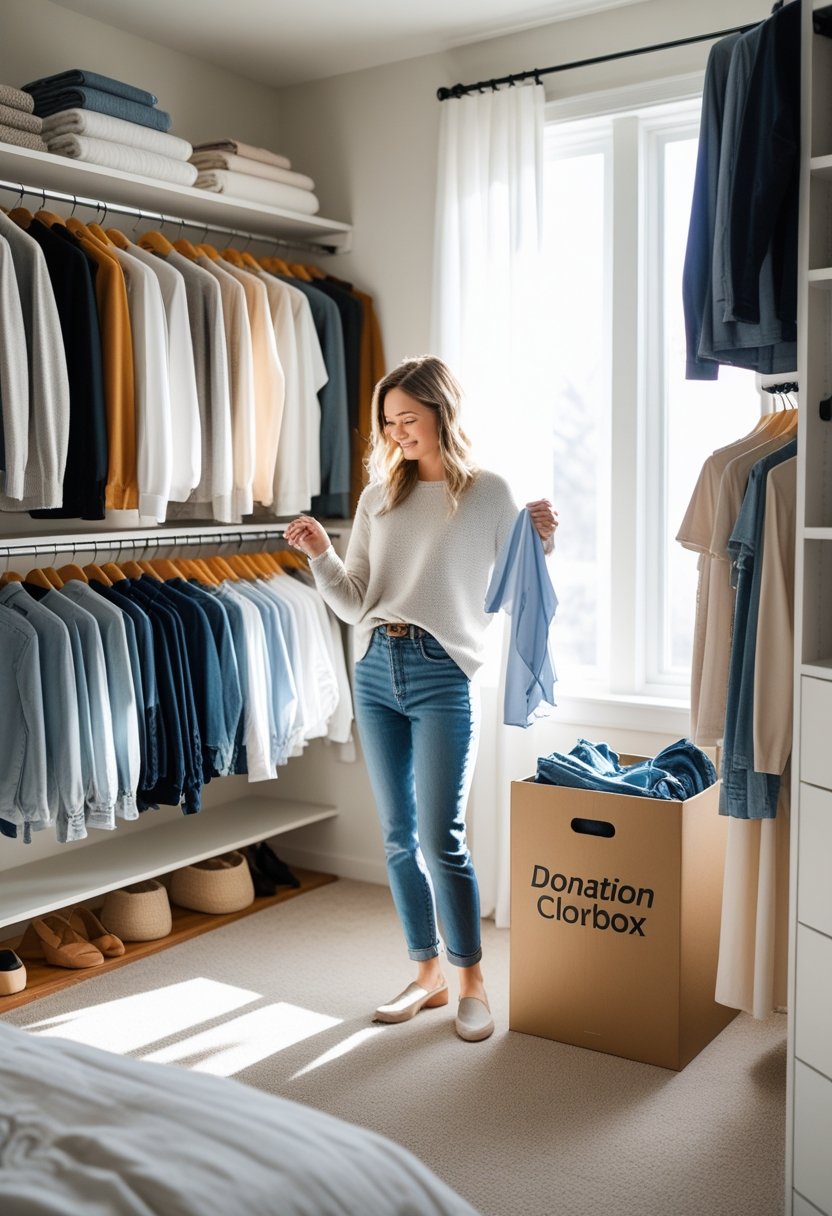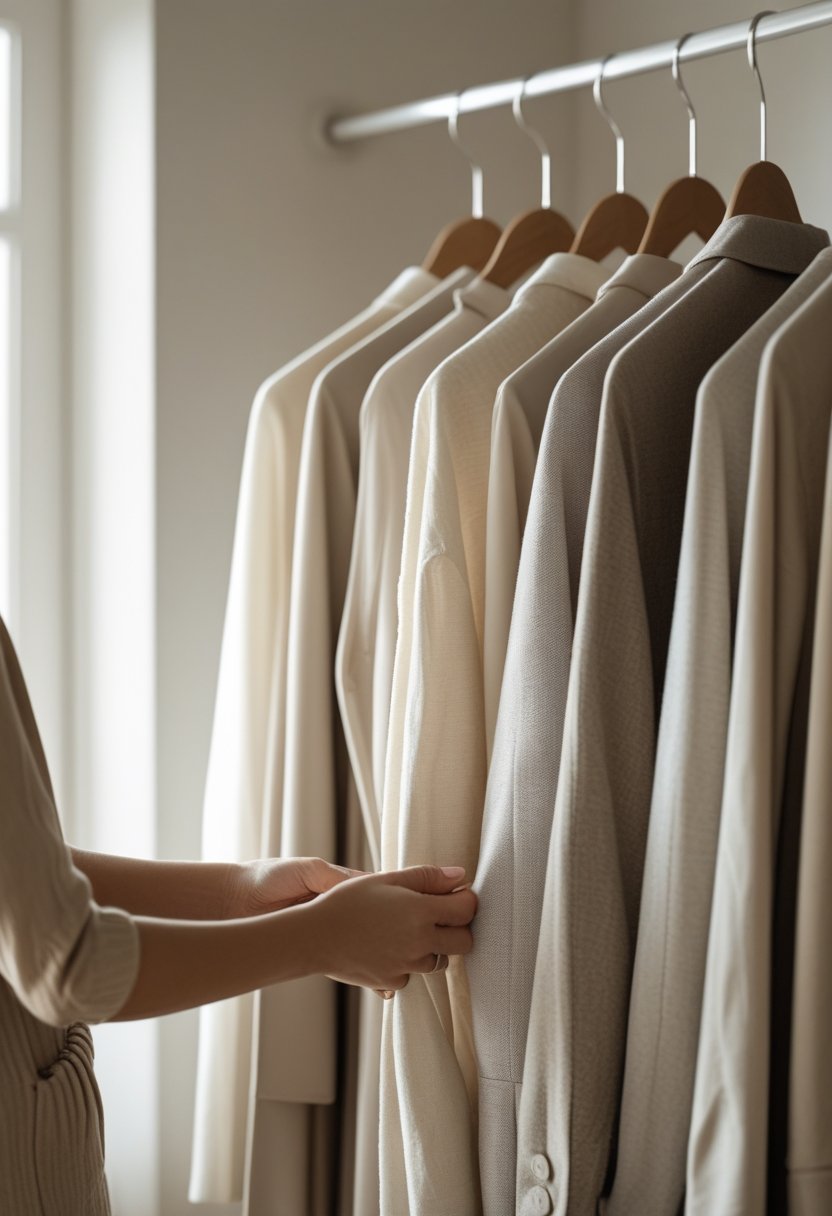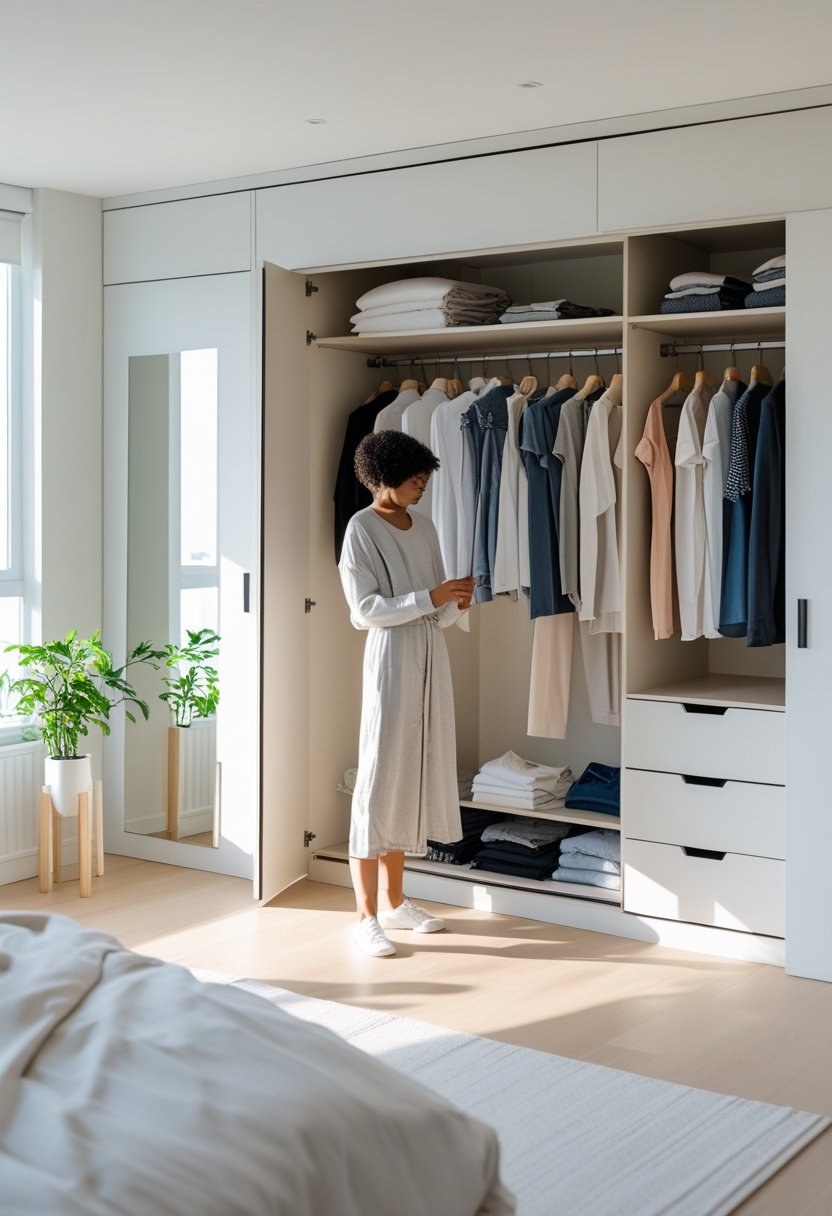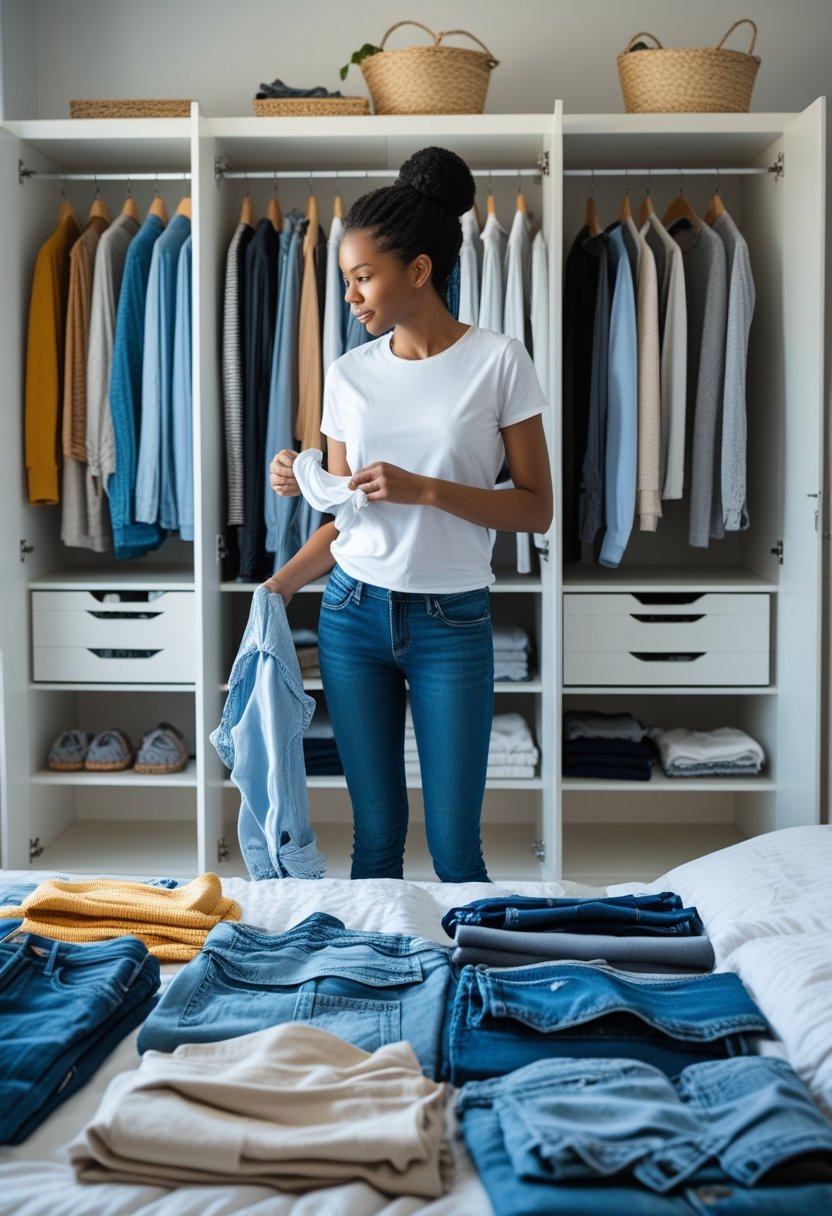When I decided to purge my clothes, I quickly realized that the process is more about mindset than just sorting through fabric. Changing how I think about my wardrobe made it easier to let go of pieces that no longer serve me.
Understanding the right mindset shifts is essential to editing your closet effectively and without unnecessary stress. This article will help you approach purging your clothes with a clearer, more focused attitude, making the whole experience more manageable.
Adopt a ‘less is more’ philosophy to focus on quality over quantity
When I started purging my clothes, I realized that owning fewer items of higher quality changed everything. Choosing quality over quantity means I invest in pieces that last longer and feel better to wear.
Less stuff reduces decision fatigue and makes my wardrobe easier to manage. It also helps me avoid buying items that quickly wear out or go out of style.
I focus on durability and timeless design rather than trends. This approach fits my lifestyle and supports smarter spending habits.
By embracing this mindset, I find more satisfaction in my clothes because each piece serves a purpose. Reducing excess isn’t about having less for the sake of it, but about making selective choices that improve how I live and dress.
This idea aligns with a minimalist lifestyle where I prioritize what truly matters. It’s a shift from collecting many things to appreciating the few that are well-made and meaningful to me. For practical ideas on this approach, see more on adopting quality over quantity.
Use a Maybe Bin for items you hesitate to discard
When I struggle to decide whether to keep or toss something, I use a Maybe Bin. It’s a simple container where I place clothes I’m unsure about. This helps me avoid impulsive decisions while still making progress in purging.
I store the bin somewhere out of sight, like under the bed or in a closet. After a set time, usually six months, I revisit the bin. If I haven’t missed or needed anything inside, I let the items go.
This approach takes the pressure off immediate choices while revealing what I actually use. It’s especially helpful for items with sentimental value or occasional use. Using a Maybe Bin makes my wardrobe editing clearer and more manageable without cluttering my space unnecessarily.
For more insight, the concept is well explained in this Maybe Bin decluttering hack.
Ask if each piece reflects your current style and lifestyle
When I purge my clothes, I start by considering if each item truly fits my current style. Styles evolve, and what I loved years ago might not suit who I am now. Holding onto something out of nostalgia or obligation only clutters my closet.
I also ask if the piece works with my daily routine. If I rarely wear formal clothes because my lifestyle is casual, those dresses take up space unnecessarily. Clothes that don’t match the life I live end up ignored.
Sometimes, I realize items don’t fit my practical needs either. Even if they look good, if they’re uncomfortable or don’t work for my climate or activities, they don’t belong in my wardrobe.
Evaluating clothes this way keeps my closet purposeful. It’s about keeping what serves me now, not what might someday. This mindset shift simplifies decisions and makes the purge more effective.
For more ideas on deciding what to keep, see how others approach evaluating their wardrobe based on style and lifestyle at Live The Minimalist Lifestyle.
Visualize your ideal wardrobe to identify unnecessary items
I start by imagining what my perfect wardrobe looks like. This helps me focus on the pieces I truly want to keep and those that don’t fit my style or needs.
Creating a mood board or using an app can make this process easier. It gives me a clear visual reference of the colors, styles, and types of clothes I want.
When I compare my ideal wardrobe to what I currently own, I spot items that don’t match my vision. These become the ones I consider removing.
Visualizing also helps me avoid impulse decisions. Instead of holding onto everything, I make choices based on whether something fits my ideal style.
This mindset minimizes clutter and makes my closet more functional. It keeps the focus on clothes that I will actually wear and enjoy.
For more on how visualization can help clarify what to keep or remove, see this wardrobe decluttering guide.
Accept that holding onto ‘just in case’ items hinders progress
I realized that keeping clothes “just in case” often stops me from moving forward with my wardrobe. These items rarely get worn, yet they take up space and clutter my closet. Holding onto them creates unnecessary mental and physical baggage.
When I accept that “just in case” means “probably never,” it becomes easier to let go. I don’t need to prepare for every imaginable scenario. Instead, I focus on what I actually use and enjoy.
This mindset shift frees up room for clothes that suit my current style and lifestyle. It also helps me avoid the trap of procrastination and fear that often fuels clutter. Accepting this truth has been key in editing my wardrobe effectively.
If you struggle with this, consider how much space you could gain by releasing items you don’t need. This clarity makes the purging process less overwhelming and more productive. For more on letting go of “just in case” clutter, see how to stop holding onto ‘just in case’ items.
Commit to taking everything out for complete wardrobe clarity
The first step I take when purging clothes is to remove every item from my closet. This means emptying the entire space, including drawers and any other storage areas where clothes might be kept. Taking everything out helps me see the full scope of what I own.
Having an empty closet gives me a clear, blank slate. It prevents me from overlooking anything hidden in the back or pockets. When I can physically hold each piece, I’m better able to assess its value and usefulness.
This method also stops me from making decisions based on convenience or habit. Instead, I focus on what truly fits my style and needs. Clearing out everything at once gives me the clarity I need to make thoughtful choices about what stays and what goes.
If you want to learn more about why emptying your closet completely works, you can check out this detailed guide on how to purge your closet effectively.
Focus on how clothes make you feel, not just their utility
When I edit my wardrobe, I don’t just consider whether a piece is practical. I pay close attention to how it makes me feel when I wear it. Clothes impact my confidence and mood in ways that go beyond function.
Some items might be comfortable but leave me indifferent or uninspired. Others, even if less practical, can boost my energy and sense of self. This emotional connection helps me decide what stays and what goes.
I remind myself that my wardrobe is a tool for my mindset. Wearing clothes that align with how I want to feel sets the tone for my day. This mindset shift transforms purging into a thoughtful process instead of a chore.
Recognizing the psychological effects of clothing has made me more intentional. It’s not just about utility or trends, but about choosing pieces that support my goals and personal expression. This approach simplifies decisions and results in a closet that reflects my true self.
For more insight, see this article on how clothes affect your confidence.
Understanding Emotional Attachments to Clothing
Emotional ties to clothes often come from memories, identity, or feelings of obligation. These connections can make it hard to part with items, even when they no longer serve my current needs or style. Recognizing what drives these feelings helps me make clearer decisions.
Why Letting Go Feels Difficult
Letting go of clothes is tough because items often symbolize moments or people in my life. Nostalgia creates a strong pull, making me hesitate to discard pieces linked to important events or relationships. I also notice a sense of waste when I consider giving away clothes I invested in, which is known as the sunk cost fallacy.
Another challenge is uncertainty—wondering if I might need the item later. This fear causes me to hold on “just in case,” even if wearing the piece is unlikely. A strategy I use is to separate emotional reasons from practical ones when sorting clothes.
The Role of Identity in Wardrobe Choices
My clothes reflect parts of who I am, shaping how I present myself to the world. I’ve realized that certain garments connect to how I see my style, profession, or personal story. Letting go can feel like losing a piece of my identity.
At the same time, identity is fluid. What fit my image years ago may no longer align with who I am today. By focusing on clothes that support my current goals and lifestyle, I can build a wardrobe that truly represents me. This mindset helps me release items without guilt.
For more about managing emotional attachments, see how mindset shifts can help during a closet cleanout at 7 Essential Closet Clean Out Mindset Shifts.
Sustaining a Clutter-Free Closet
Keeping my closet organized takes ongoing effort and practical changes to daily routines. I focus on replacing habits that lead to clutter with consistent, manageable practices while maintaining motivation to stay committed over time.
Replacing Old Habits with New Practices
I stopped leaving clothes on the floor or draping them over furniture by setting clear habits. For example, I hang or fold every item immediately after wearing it instead of letting it pile up.
I also limit new purchases by assessing whether an item fits my current style and wardrobe goals before buying. Avoiding impulse buys helps prevent unnecessary clutter growth.
Using a system like assigning specific spots for categories (tops, pants, shoes) ensures I always know where things belong. This reduces the chance of misplacing clothes or creating messes.
Building Long-Term Decluttering Motivation
I keep motivation by regularly reviewing how my wardrobe supports my lifestyle. Every few months, I revisit my closet and remove anything no longer useful or fitting well.
Setting small, achievable goals helps me avoid feeling overwhelmed. For instance, I might decide to donate five items each time I purge.
Tracking progress visually, such as maintaining a checklist or before-and-after photos, reinforces the satisfaction of an organized space. This ongoing feedback keeps me driven to maintain a clutter-free closet.
For more ideas on editing your wardrobe thoughtfully, see this guide on how to purge clothes effectively.

Hi, Ehtesham Here, I like to upload content about fashion and scents, and I love sharing ideas. My goal is to help others in finding outfits and Scents.







